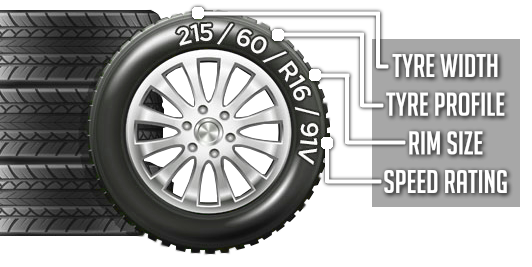The markings and writing on your tyre not only state the brand and model of the tyre, but also the sizes, width, aspect ratio, and load and speed rating.
For example, a tyre may say 215/60/R16. This would mean that the tyre is 215 mm wide, the 60 is an aspect ratio. This ratio is what the height of the tyre sidewall is, in relation to its width. So in this example, the tyre wall is 60% of the tyres width.
Next is R16, which tells us two things, the ‘R’, that the tyre is of radial construction, the 16 tells us what diameter wheel these tyres are designed for.
So this tyre is telling us it’s a radial tyre, 215 mm wide, with a tyre wall 60% of its width, which will only fit 16 inch wheels.
The next two sets of numbers and letter are the load index, and speed rating. So if we use the same 215/60/R16 tyre, we now see a number and a letter.
The number is the load index, this tells us the weight that each tyre can carry, the letter is the speed rating, denoting what maximum speed the tyre can safely drive at.
So from the example, we see that this tyre has been rated 91 V. From the charts below we can see that this tyre is rated to carry no more than 615 KG per wheel. So a total vehicle weight of 2,460 KG (the average vehicle weight being about 1,400KG) is permitted. The speed rating on the example tyre V, means that it is not recommended by the manufacturer to exceed 150mph.
